- Register
- Log in to Tune-In
- Wishlist (0)
-
Shopping cart
(0)
You have no items in your shopping cart.
Beatles News
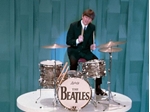
Colts owner Jim Irsay didn't add a fourth Beatles guitar to his collection this weekend, but he did pick up an iconic piece of Fab Four history. Irsay paid $2.125 million for the bass drum head used by Ringo Starr during the Beatles' 1964 performances in the United States -- including appearances on "The Ed Sullivan Show" and two concerts at the Indiana State Fair. The band's Feb. 9, 1964, visit to Sullivan's program launched the "British Invasion" of rock music and introduced U.S. viewers to John Lennon, Paul McCartney, George Harrison and Starr.
"Mr. Irsay is thrilled to be able to bring this special piece of music history to Indianapolis," said Chris McKinney, curator of Irsay's rare guitars and collectibles "One of the largest television audiences ever watched the lads for the first time and had that logo etched into their minds forever."
The "drop-T" logo drum head, a 20-inch model made by Remo and originally attached to Starr's Ludwig kit, was auctioned Saturday by Julien's in Los Angeles. Before the auction, experts predicted a bid in the neighborhood of $1 million would secure the drum head.
The auction also featured John Lennon's 1962 J-160E Gibson acoustic guitar, which sold for $2.41 million t details

"I wanted to put out what I felt about revolution. I thought it was time we spoke about it," John Lennon told Rolling Stone in 1970. With "Revolution," The Beatles songwriter "wanted to tell you, or whoever listens, to communicate, to say 'What do you say? This is what I say.'
" Lennon wrote "Revolution 1" -- and, subsequently, the faster single version, "Revolution" -- with the dual purpose of glorifying the spirit of the idea as well as calling out its potential for charlatanism. With the context-less and wide-ranging lyrics, such as, "But if you want money / For people with minds that hate / All I can tell you is brother, you have to wait," Lennon's intentions with the song were not explicitly clear, meaning it could have broader appeal.
But an interview with film director Michael Lindsay-Hogg, exclusively provided to The Huffington Post with the recent release of "The Beatles 1" video set, provides a new entry point for the song. Lindsay-Hogg, who directed four music videos for The Beatles, recalled Lennon instructing him when they shot the "Revolution" video in 1968: "Whatever else you do in the song, I think I ought to have a close-up" on the line, "But if you go carrying pictures of Chairman Mao / You ain details
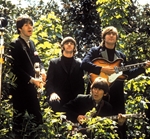
Michael Lindsay-Hogg’s five-decade career as television, film, and theater director has spanned everything from Ready, Steady, Go! to Waiting for Godot. There was also a period, in the mid-1960s, when he made something called promos for a band called the Beatles.
“Promo” was the term for what, in the fullness of time, would become known as the music video. And it’s impossible to imagine a better crash course on the early days of the form than the three new editions of the Beatles’ hits package, 1, coming out this weekend, in time (per long-standing Fab Four tradition) for holiday wish lists. The set includes the deluxe 1+, a whopping package of 50 gorgeously restored videos, with new stereo and 5.1 remixes by Giles (son of George) Martin. Forget the bootleg, third-generation, Betamax versions on YouTube. Frame by frame, new aural and visual wonders are revealed here, from the bristling guitars on “Paperback Writer” to the graffitied “STONES” that can now be clearly seen on a Penny Lane street sign.
Lindsay-Hogg, who shot the Beatles at critical career junctures (including Let It Be, the film that unsuspectingly captured their breakup), remembers what it was l details

Fox News Channel’s Howard Kurtz has whipped up some must-see TV for fans of The Beatles. On tomorrow’s MediaBuzz at 11 a.m. ET, Kurtz has an exclusive interview with a doctor who claims to have operated on Beatles’ music legend John Lennon. He will reveal the inaccuracies that have colored decades of reporting on what really happened on the night he was brought to a New York hospital on Dec. 8, 1980.
I was stunned to learn that after 35 years of reporting, the media narrative of what happened to John Lennon when he got to the hospital on that fateful night was deeply flawed. From medical details to the reaction of Yoko Ono, we will shed new light on a tragedy all of us so vividly remember,” Kurtz told TVNewser.
Kurtz will use interviews with key eyewitnesses who have not spoken out before to examine the embellished accounts that have developed over the years. The program also will touch on how Yoko Ono was depicted in the media following her husband’s death.
By: Brian Flood
Source: TVNewser
details
John Lennon's long-lost acoustic Gibson J-160E, used in the recording of the Beatles' Please Please Me and With the Beatles LPs, shattered all estimates Saturday on the Julien's Live auction block, as the instrument sold for $2.41 million, a record for a guitar with music history significance. Lennon purchased the Gibson at Rushworth’s Music House in Liverpool in September 1962 for £161. The guitar, which was lost for over 40 years, sold for three times its $800,000 estimate to an unspecified buyer who asked to remain anonymous.
t's unclear how Lennon was separated from the instrument, which was also used on the Beatles' first single "Love Me Do" / "P.S. I Love You," but it resurfaced in a San Diego music shop in the summer of 1967; however, the purchaser had no idea the guitar once belonged to Lennon. It wasn't until 2008 that the guitar's provenance was discovered. "Its importance in Beatles history cannot be overstated; this guitar is intimately bound to the early career of The Beatles," Julien's Live said of the guitar. "This is the earliest and most significant John Lennon guitar to be auctioned."
By comparison, Lennon's Gretsch guitar, used on the Beatles' 1966 single "Paperback Wri details
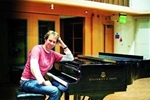
Giles Martin, son of producer Sir George Martin, talks about working on the new stereo and surround audio mixes of the Beatles, his favourite song of the group and more..
How did you first come across the Beatles' music?
The Beatles had agreed to let their music be used for the Love project. I was interviewed for this by their people and I just thought it would be fun. They told me I had three months. I remember working on Within You, Without You and Tomorrow Never Knows. They liked my approach and fresh attitude towards the music. And since then, I've been working on the Beatles music.
In dealing with their catalogue, did you ever feel overwhelmed? Like working on music that is revered the world over...
Yes and no is the answer. If you ask Paul McCartney whether it's sacred or not, he'll say that he wouldn't want their work to be 'covered in dust'. If there are ways to improve things technically, we should do it. And I think with these new mixes on 1, they just sound more powerful because they are a throwback to the mono mixes. And obviously, we have surround sound we well. It is sacred in the sense that it means so much to so many people and the music is so important to the world. At the same t details
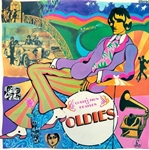
This is a weird one: An official Beatles-album that doesn’t exist. Or at least that is what EMI and Apple would have us believe. A stopgap album put together just in time for Christmas 1966 as the group didn’t have any new product ready for the Christmas-stockings, breaking a tradition they started back in 1963.
EMI probably panicked when Brian Epstein (the Beatles’ manager) informed them in late October that the group hadn’t even started recording yet. So the idea for a hit-collection was born.
As some of The Beatles’ singles had only been mixed in mono (those not included on regular albums), there was some stereo mixing to be done. George Martin did the stereo mix of “Paperback Writer” on October 31, and proceeded with “I Want To Hold Your Hand” on November 7.
The following day, November 8, Geoff Emerick took care of “She Loves You”. As the original two track master had gone missing, he had to create a fake stereo mix that sounds strange to a 2015 ear, but in the 60’s this solution was quite common.
Peter Brown took over on November 10, mixing “We Can Work It Out”, “Day Tripper” and &ldqu details
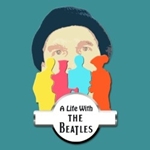
For the first time in London after the great success at the Edinburgh Fringe Festival, A Life With the Beatles is an amazing Magical Mystery Tour of the Beatles’ history, focused on the night of the recording of A Day in the Life, the song that closes their most famous album, Sgt. Pepper's Lonely Hearts Club Band.
This incredible story is told from Neil Aspinall’s perspective, the Beatles’ road manager since the early days in Liverpool, the only one who was always at their side, behind the scenes and away from limelight, from 1961 to the 1970 break-up, and who later became the CEO of Apple Corps.
He’s the only one who can tell the whole story. A tale that deserves to be told, because we can grow only knowing the tale of the past from men and women who has been involved.
A Life With the Beatles will recall the Fab Four’s history with this unique account. It won't be a nostalgic tale, but a celebration of what the Beatles represented for that generation and the ones who follow. A hour in the life of Sgt Pepper and Neil Aspinall involving the audience all the way in a tour of 60s memorabilia, anecdotes and insight.
To thank for the love the Beatles gave the world. To ma details

In 1965 or 1966 Canadian musician Andy Maize’s mother took his oldest brother to see the Beatles at the Montreal Forum. He was just a kid, but he remembers it was a big deal.
“They only played for half an hour and the screaming was so loud she couldn’t turn her head. If she turned her head, it hurt too much,” Maize recalls. “My mother is now 90 years old, and I think it’s pretty cool she got to see the Beatles. I had an idea what a big deal it was then. I remember all sorts of merchandise. There were lunch boxes.”
Fifty years later, Maize is touring as one of the featured vocalists in Art of Time Ensemble’s orchestral concert performance of the Beatles’ “Sgt. Pepper’s Lonely Hearts Club Band.” The Canadian collective assembled by classical pianist Andrew Burashko has been re-imagining orchestral, theatrical and concert pieces since 1998. Performances of works by the Beatles, Frank Zappa and jazz composer Erwin Schullhoff and an exploration of Rom music are some of its recent projects.
Maize first performed “Sgt Pepper” with Art of Time Ensemble for the album’s 45th anniversary in 2012.
“Often the shows details

I'm guessing Adele must be pretty damn chuffed right now: a number one single, an imminent new album that's bound to take top slot and half the planet going nuts with joy that she's back making music.
And good for her. She deserves it. Not only is she a talented woman with an amazing voice and a gift for writing fine songs, she also seems like a thoroughly decent human being.
So I don't suggest she watches ITV's upcoming special The Nation's Favourite Beatles Number One. It'll only depress her.
I've just had a sneak preview of this thing, and I defy anyone not to draw the same admittedly rather bonkers-sounding conclusion as I did. Namely, that the Beatles really were SO good, that their music really was SO ground-breaking, that every act that's followed - yes, seriously, every act, in the 45 years since they split up - must know, deep down, that they can never really match them.
I've singled out Adele not to be mean but purely because she happens to be the most currently prominent example of someone who's trying - writing her own songs, performing them, doing her own thing.
Obviously a billion other solo acts and bands have taken the same route over the years and, like Adele, done very n details

Beatlemania is heading to capital, as the Dublin Beatles Festival gets ready to open it's doors on Friday.
Running from November 6 to November 8, the three-day festival celebrates the fab four's performance in Dublin on November 7, 1963.
A number of Irish and international bands will take to the stage, as plays, memorabilia, art and film fill out a jam-packed programme. One of the films, Good Ol' Freda, will be screened at the Grand Social on Sunday, November 8.
The award-winning documentary is about Freda Kelly, who ran the Beatles' fan club was the secretary to their manager Brian Epstein for over a decade. She became friends with the band through attending 180 of their lunch time gigs in Liverpool's Cavern Club - but refused to speak about or profit from her time working for the band.
When her grandson arrived, she wanted to be able to share her experience with the Beatles - and will be making a rare public appearance at the festival. Paul McCartney's stepmother called the film "one of the last true stories of the Beatles that you'll ever be able to hear."
Other highlights from the weekend festival include The Beatles Session at the Cobalt, featuring Jonathan Ward, Vyvienne Long, Biggl details

Mid-late 1960s: West goes East. While it was John Lennon, Yoko Ono and Canada that initiated Rock n' Roll Diplomacy, George Harrison was the first to apply that concept to music.
Through Harrison, The Beatles were the first Western Rock band to use non-Western instruments. Having been intrigued by the sound of a Sitar during the filming of Help!, Harrison went on to learn how to play it with Ravi Shankar. Harrison would first play the Sitar on the introduction to the ballad "Norwegian Wood" (1965) - prompting the Rolling Stones to follow suit in "Paint it Black."
While playing short Indian instrument passages on Beatles tracks, such as "Tomorrow Never Knows" and "Strawberry Fields Forever", Harrison went one step further by convincing his band-members to expand their repertoire by including tracks in which he sang to Indian instruments: from the cynical "Love You To" (1966), to the cosmic Within You, Without You (1967), and the transcendental "The Inner Light" (1968).
Harrison would also produce, in Bombay and London, Wonderwall Music, the soundtrack of the homonymous movie, combining Indian compositions with psychedelic Rock. Thereafter, during the Beatles' post Sergeant details

The sound of the Fab Four is of course what made the Beatles over the span of one joyous decade, during which they used their unbeatable songwriting polish and boundless creativity to deliver the soundtrack for a generation—the biggest band in the world.
But the sight of those long-haired lads from Liverpool also helped complete the package, with everything from their fashion to the Beatles haircut to John’s rapscallion sneer, Paul’s cherubic grin, stern-faced George and the sight of good-natured, jolly Ringo complementing the fandom. Which is why new Beatles releases on the way this week—1 and 1+, which collect the band’s 27 No. 1 singles released between 1962 and 1970, remixed for a new generation of fans—also include treats like restored promotional videos and films that span the entirety of the Beatles’ existence.
The Beatles’ Apple label says it dug deep into its vaults for the packages, with the videos taking us all the way back to the early days. Set for release on Nov. 6, the result is an evocative visual and audio reminder of how the band got to the top and how it stayed there.
In “We Can Work it Out,” for example, we see an early John details

A miniature Bible owned by Eleanor Rigby - the star of the classic Beatles tune - has been put on sale for the first time. The piece of pop memorabilia, which bears the signature of the so-called 'lonely woman' Rigby, is expected to fetch as much as £20,000 at auction thanks to its connection with the song's mysterious central figure. Rigby died in 1939, long before the Beatles had formed, but her grave stands in a Liverpool ceremony where John Lennon and Paul McCartney used to meet and compose songs.
McCartney has claimed that the song was not an intentional reference to the woman - whose name he invented for the purposes of the song. But he admits the name could have ended up in the back of his mind after spending time near the headstone at St Peter's church in Woolton, and made its way into musical history from there.
Rigby, held up in the 1966 song as an example of 'all the lonely people' had a life with similarities to the figure described in the song. She too could be classed as lonely, having been unmarried for most of her life. She married at the age of 35 - extremely late for the time - to a much older man and died less than ten years later. She never had children.
And she was details
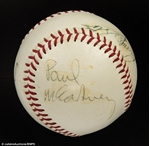
An extremely rare baseball signed by all four Beatles on their last ever tour of the US has gone on sale with a staggering $100,000 price tag.
Paul McCartney, John Lennon, George Harrison and Ringo Starr each scribbled their signature on the ball after playing the DC Stadium in Washington DC on the fourth date of their 1966 tour on August 15.
The band's signatures were notoriously hard to come by but when Fred Baster, the equipment manager of the Washington Senators baseball team, asked them to sign three baseballs for him they obliged.
Mr Baster kept two for himself and gave another to Senators pitcher Mike Cronin. This Joe Cronin Official American League baseball, housed in a velvet-lined wooden box, is one of the two that belonged to Fred Baster. An engraved plaque on the box reads 'Beatles 66 £2'.
It is tipped to sell for $100,000 - around £65,000 - at Julien's Auctions in Los Angeles. Darren Julien, from the auctioneers, said: "There are only three baseballs in the world signed by the Beatles, and this is one of them.
"The band had just played their fourth gig of their 1966 US tour when Fred Baster, the equipment manager for the Senators, approached them details
